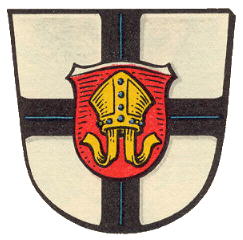Massenheim (Hochheim am Main): Difference between revisions
Knorrepoes (talk | contribs) m (Text replacement - "Abbott" to "Abbot") |
Knorrepoes (talk | contribs) m (Text replacement - "===Official blazon=== *(de) ===Origin/meaning===" to "{| class="wikitable" |+Official blazon |- |'''German''' | |- |'''English''' | {{blazon wanted}} |} ===Origin/meaning=== ") |
||
| Line 8: | Line 8: | ||
[[File:massenhe.jpg|center|Wappen von {{PAGENAME}}]] | [[File:massenhe.jpg|center|Wappen von {{PAGENAME}}]] | ||
= | {| class="wikitable" | ||
|+Official blazon | |||
|- | |||
|'''German''' | |||
| | |||
|- | |||
|'''English''' | |||
| {{blazon wanted}} | |||
|} | |||
===Origin/meaning=== | ===Origin/meaning=== | ||
The arms were proposed in 1956, I have no idea whether the arms were actually granted. | The arms were proposed in 1956, I have no idea whether the arms were actually granted. | ||
Revision as of 08:15, 5 July 2022
This page is part of the German heraldry portal |
Heraldry of the World |
|
German heraldry:
|
Selected collector's items from Germany:
|
MASSENHEIM
State : Hessen
District (Kreis) : Main-Taunus Kreis
Incorporated into : 1977 Hochheim am Main
| German | |
| English | (Hochheim am Main) No blazon/translation known. Please click here to send your (heraldic !) blazon or translation |
Origin/meaning
The arms were proposed in 1956, I have no idea whether the arms were actually granted.
The village historically was a possession of the Abbey of Fulda, and later of the Lords of Eppstein and the Counts of Hessen. In 1803 the village became part of Hessen-Nassau. The arms refer to the century-long rule of the Bishop-Abbots of Fulda, which is shown by the black cross of the diocese of Fulda and the mitre as a symbol for the Bishops.
The cross also refers to the local church, which is devoted to the Holy Cross.The oldest known seal of the village council, known from 1575-1629, as well as the second seal, known from 1650, show a standing bishop, holding a crosier and book. These obviously refer to the Bishops of Fulda.
The 18th century seal shows a pilgrim. In the 19th and early 20th century the seals showed only the lion of Hessen or Nassau. Only in 1935 a new seal was made, again with the pilgrim.
The above proposal returned to the oldest seals, but translated in a more heraldic design.
Contact and Support
Partners:
Your logo here ?
Contact us
© since 1995, Heraldry of the World, Ralf Hartemink 
Index of the site
Literature : Hessisches Wappenbuch, 1956












